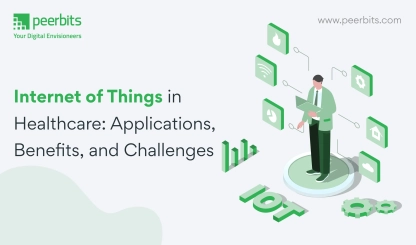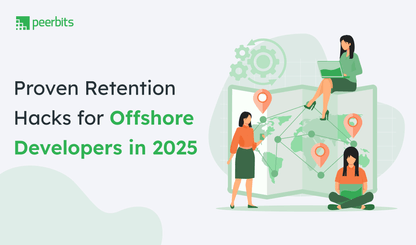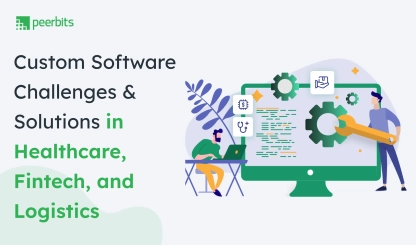Web application development has evolved significantly over the past decade. What once started with basic static web pages has now transformed into highly interactive, scalable, and feature-rich applications that rival native mobile experiences.
Building a successful web application requires more than just coding—it demands strategic planning, a strong architecture, the right web app development technologies, and a skilled development team.
Choosing the right tech stack, understanding web application development costs, and selecting the best web app frameworks are all critical steps in this process.
If you're looking to develop a web application that delivers real business value, this guide will walk you through the entire web application development process—from fundamentals to execution. Let’s get to it!
What is a Web Application?
In layman’s terms, a web application is any kind of online service that is accessible through a web browser.
It is basically a computer program that runs on a web server and can be accessed via a web browser & an active internet connection.
A web application generally consists of two main parts – Server-side & Client-side.
The server-side helps to store & retrieve data, while the client-side helps to display the retrieved data to end-users on the front-end of a web application.
Web app development process
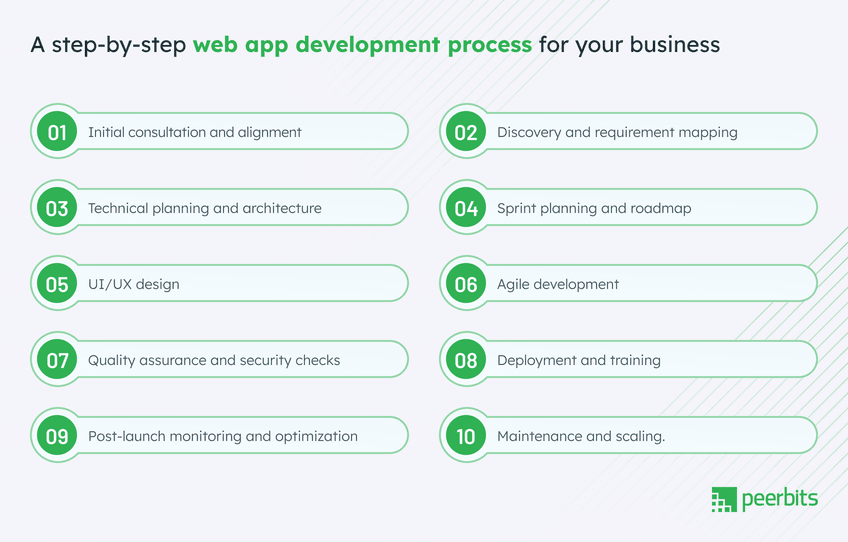
When you hire offshore development team, you’re not just buying coding hours. You’re investing in a structured web app development process that should give you clarity, predictability, and confidence. Here’s what that process looks like from your perspective:
1. Initial consultation and alignment
This is where you sit down with the team to discuss your goals, budgets, and timelines. Think of it as setting the ground rules before development begins. It gives you a clear sense of whether the team understands your business needs and expectations.
2. Discovery and requirement mapping
At this stage, you and your developers work together to map out features, user journeys, and success metrics. By locking these in early, you avoid scope creep and keep the Agile process sharp and focused on what matters.
3. Technical planning and web application architecture
This step ensures the foundation is strong. The team defines the tech stack, third-party integrations, and web application architecture. For you, this means fewer surprises later, lower risks, and a system that can scale with your business.
4. Sprint setup and roadmap
Here, the sprint structure for offshore teams comes into play. You get clarity on who owns what, how progress will be reported, and when you’ll see updates. A clear roadmap helps you stay in control without micromanaging.
5. UI/UX design
Wireframes and prototypes show how users will interact with your app, helping validate flows, check usability, and ensure your website design for startups aligns with customer needs before development.
6. Agile development
The actual build happens in short sprints. You’ll receive regular demos, give feedback, and see progress unfold in real time. The Agile development process makes it easier for you to pivot if priorities shift without derailing the entire project.
7. Quality assurance and security checks
This is where your confidence grows. The team tests every feature for bugs, performance, and compliance. With strong QA, you can trust that offshore team performance won’t falter once the app is in users’ hands.
8. Deployment and training
When it’s time to go live, the team takes care of backups, monitoring, and rollouts. For you, deployment and training should feel smooth, with zero surprises, and complete transparency about risks.
9. Post-launch monitoring and optimization
After launch, your app isn’t left unattended. You’ll see analytics, performance data, and user behavior reports. This feedback loop confirms whether the app is delivering on the goals you set in step two.
10. Maintenance and scaling
Your business won’t stand still, and neither should your app. With ongoing offshore support, you can add features, strengthen security, and scale performance. This turns the development team into a long-term partner rather than a one-time vendor.
Benefits of Web Application Development
Web app development is all about creating a specific internet application or a platform that performs predefined functions by storing & displaying data using a server-side programming model.
Using a website builder can simplify the process by providing ready-made tools and templates to quickly design and launch web applications without extensive coding.
Nowadays, people hire web app developers to boost their online businesses, considering the hype & use of web apps.
It is also a quite cost-effective solution that helps online businesses to reach new customers through the internet.
Following are some of the key benefits of web app development.
Reach across devices: A single web application works seamlessly on iOS, Android, Windows, and other operating systems through any modern browser. You don’t need to build separate native apps for each platform, which saves time while still giving your users consistent access.
Cost-effective investment: Since one application can serve all platforms, development and maintenance costs are far lower compared to building multiple native apps. This makes it a practical option for businesses that want to expand reach without overspending on tech.
Instant user access: Unlike native apps that require downloads and installations from app stores, web applications can be opened instantly via a simple URL. This ease of access reduces barriers for users and helps your business engage customers faster.
Simplified updates: Updates are managed on the server side, which means users always see the latest version without needing to manually update the app on their devices. This reduces maintenance effort and improves reliability.
Improved brand visibility: A dedicated web application can highlight your services, showcase your values, and strengthen your digital presence. It becomes a direct channel for building brand awareness and reaching new customers online.
Web app development trends
Web applications are no longer just digital add-ons, they’re becoming the backbone of how businesses engage with customers and streamline operations. The web app development process today is shaped by new technologies and changing user expectations.
Here are the trends you should know if you’re planning to invest in web application development:
- Progressive web apps (PWAs): They deliver fast, reliable performance and offline access, giving users a mobile app-like feel without the cost of building separate native apps.
- Single-page applications (SPAs): These apps load content dynamically, improving speed and user experience by avoiding full page reloads.
- Cloud integration: Companies are shifting web applications to the cloud for better scalability, reduced infrastructure costs, and stronger data backup options.
- AI and automation: From chatbots to smart recommendations, AI is being integrated into web applications to personalize experiences and improve decision-making.
- Focus on security: With sensitive business and customer data at stake, security-first practices are now a key part of every Agile development process.
Staying aligned with these trends helps businesses create web applications that are scalable, secure, and relevant to how users interact online today.
How to evaluate web application development cost?
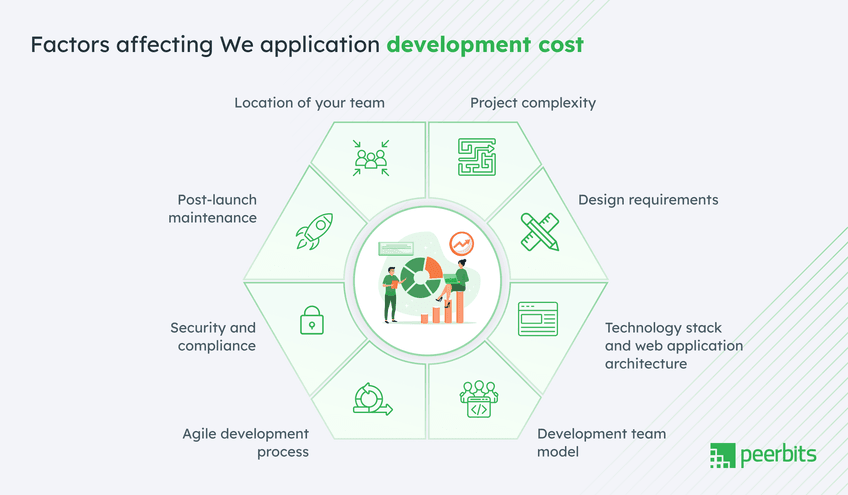
The cost of web application development isn’t fixed. It depends on a mix of technical and business factors. Understanding these helps you plan your budget better and avoid surprises down the road.
1. Project complexity: Simple applications with basic features cost less, while complex solutions with dashboards, third-party integrations, or AI features require more development hours, which directly increases cost.
2. Design requirements: A minimal interface is faster to build, but if you want a polished UI/UX with custom animations, responsive layouts, and brand-driven visuals, it adds more to both design and testing time.
3. Technology stack and web application architecture: The choice of programming languages, frameworks, and hosting environment influences cost. For example, a microservices-based web application architecture usually needs more planning and higher upfront investment than a monolithic build, but it scales better long term.
4. Development team model: Hiring an in-house team has higher fixed costs, while outsourcing or choosing to hire an offshore development team can reduce expenses but needs stronger sprint structure for offshore teams to keep productivity high.
5. Agile development process: Using an Agile process means costs are spread across sprints, giving flexibility to adjust priorities. This avoids paying for unused features but still requires consistent investment in planning and sprint reviews.
6. Security and compliance: Applications that handle financial data, healthcare records, or sensitive customer information must follow strict security standards. Adding encryption, audits, and compliance certifications can increase cost but protect you from bigger risks later.
7. Post-launch maintenance: Development doesn’t stop at launch. Regular updates, bug fixes, server monitoring, and scaling for more users all carry ongoing costs. Businesses often underestimate this stage, yet it’s key to long-term performance.
8. Location of your team: Rates vary widely depending on where your developers are based. A U.S. or U.K. team might cost three to four times more than a team based offshore, even when working with the same Agile development process.
In most cases, small to mid-sized business applications range from $30,000 to $120,000, while enterprise-level solutions can cross $200,000+ depending on scope. Planning around these factors ensures you balance quality, speed, and budget effectively.
Conclusion
A web application is a powerful tool for expanding your business reach and improving customer engagement. It helps streamline operations, enhance user experience, and drive growth in a competitive market.
If you are planning to build a web app, choosing the right development partner can make a significant difference. The process involves multiple stages, from planning to deployment, and having an experienced IT company by your side can simplify the journey while delivering a solution that aligns with your business objectives.

FAQs
It depends on the project scope. A basic MVP may take 2–3 months, while a full-scale enterprise application can stretch beyond 6–9 months. Timelines vary with features, integrations, and team size.
Small projects can start around $20,000–$40,000. Mid-level apps may cost $50,000–$100,000, while complex enterprise apps often exceed $150,000. The final figure depends on the development model, location of the team, and feature set.
Hiring in-house gives tighter control but higher costs. Outsourcing or working with offshore teams often reduces expenses while giving access to a wider talent pool. The choice depends on your budget, speed expectations, and long-term goals.
The stack depends on the type of app, expected traffic, and scalability needs. For example, startups often prefer Node.js, React, or Angular for flexibility, while enterprises may opt for Java, .NET, or Python for stability and integrations.
Skipping MVP validation, unclear product requirements, underestimating costs, and overlooking security are top mistakes. These lead to delays, budget overruns, or applications that don’t match user needs.
Very. With rising cyberattacks in 2025, security can’t be treated as an afterthought. Businesses must adopt DevSecOps, regular audits, and compliance with regulations to protect data and reputation.
Yes. A well-architected web app can scale both vertically (adding more resources) and horizontally (adding more servers). Planning scalability from day one saves cost and disruption later.
Post-launch support involves fixing bugs, updating dependencies, monitoring performance, and adding new features. Many businesses keep a dedicated support team or partner with a development company for ongoing maintenance.
Almost every sector uses them, but industries like fintech, healthcare, logistics, and retail heavily rely on web apps for automation, data management, and customer interaction.
If your workflows depend on manual processes, your customers demand digital access, or you want a scalable platform beyond a simple website, a web application is the right step.

